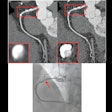"Our aim was to assess a new scanning protocol that uses a split-bolus injection for a combined pancreatic and portal-venous phase acquired with spectral MDCT," researcher Dr. Olga Brook told AuntMinnie.com. "The goal is to reduce the radiation dose while maintaining good quality of images."
Patients were randomized to either standard or split-bolus spectral CT. Standard 64-detector-row CT included noncontrast, pancreatic, and portal-venous phases, after a single contrast injection of 140 cc (n = 33). Split-bolus spectral CT (Discovery CT750 HD with gemstone spectral imaging, GE Healthcare) included a noncontrast scan, followed by a single scan acquired after two contrast injections, 100 cc and 40 cc (n = 36). Images in this group were reconstructed at 60 keV and 80 keV.
The tumor contrast-to-noise ratio in the pancreas was higher in the 60-keV split-bolus spectral CT group (8.9 ± 6.3), compared with both pancreatic (4.2 ± 3.2) and portal-venous (5.8 ± 4.3) phases of the standard protocol, according to Brook and colleagues. Attenuation was similar in the aorta but higher with split-bolus spectral imaging in the liver. The radiation dose was 49% lower using the spectral protocol.
"A split-bolus spectral CT protocol can be used for pancreatic tumor detection, staging, and follow-up instead of standard pancreatic multiphase or pancreatic CT, with better tumor conspicuity, and similar or better depiction of the arterial and portal-venous systems with nearly half of the radiation dose," Brook said.



















